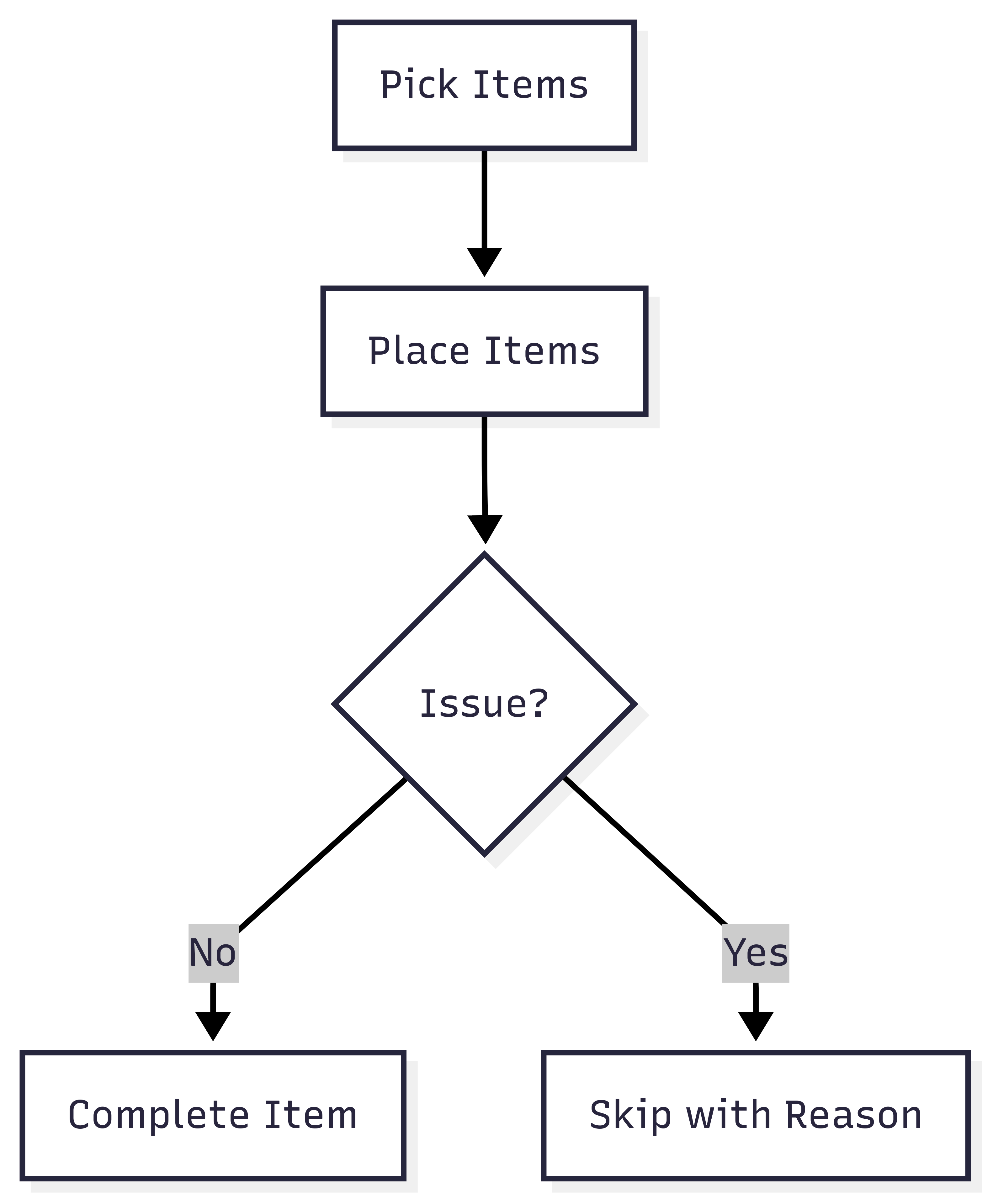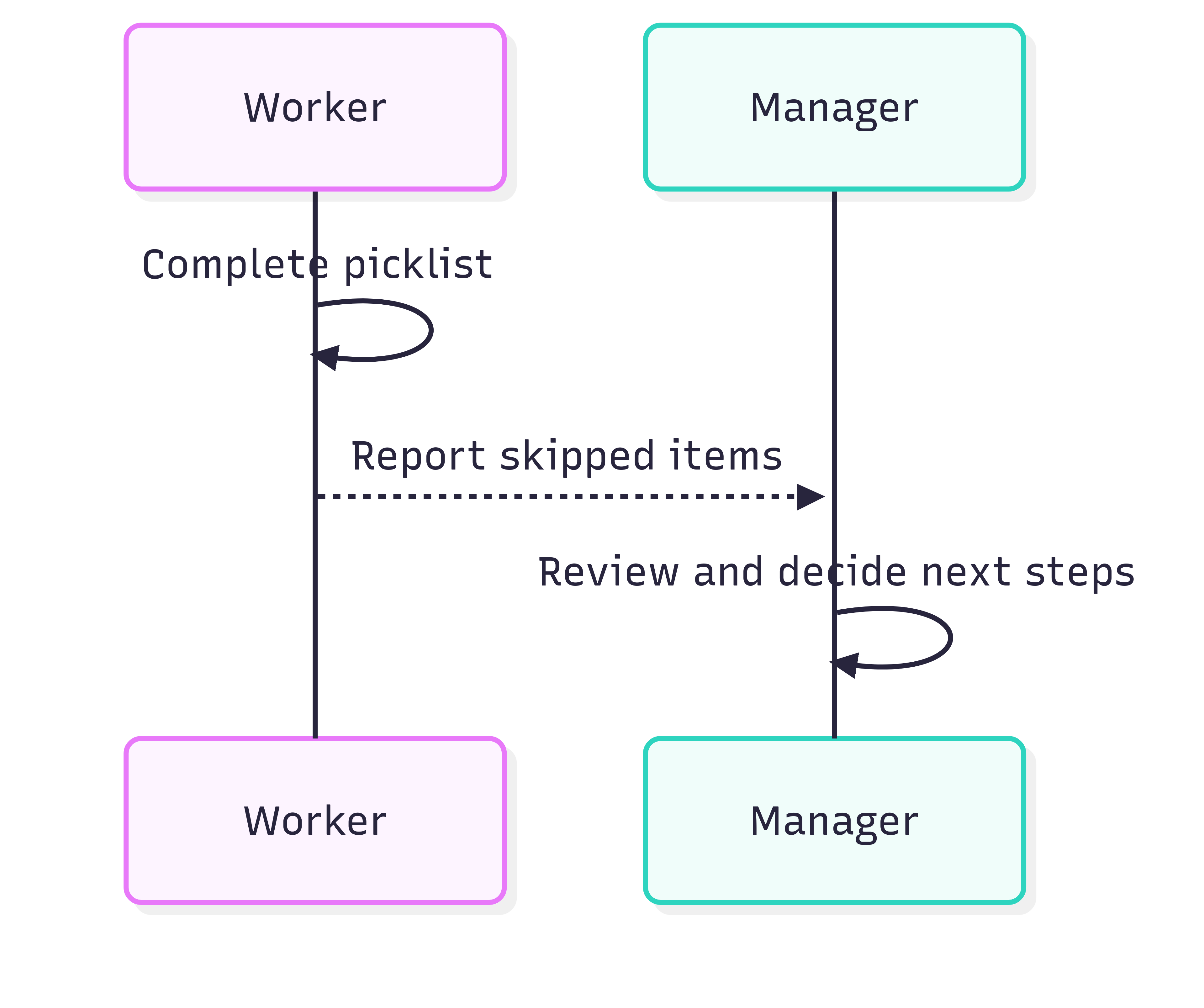Picklists
What are Picklists?
Picklists are organized task lists that help warehouse workers efficiently collect and move inventory items from one location to another. Think of them as digital shopping lists that guide workers through the warehouse, telling them exactly what to pick up, how much to take, and where to put it.
Why Use Picklists?
Picklists help your warehouse operations by:
- Organizing work efficiently - Group related tasks together so workers don't waste time walking back and forth
- Tracking progress - See exactly what's been completed and what still needs to be done
- Assigning tasks - Give specific workers their own lists to complete
- Preventing mistakes - Clear instructions reduce errors and missing items
- Recording activity - Keep track of who did what and when for accountability
- Managing priorities - Handle urgent orders first
How Picklists Work
The Picklist
A picklist is like a work order that contains:
- A list of items that need to be moved
- Who is responsible for completing the work
- The priority level (urgent, normal, low)
- Current status (not started, in progress, completed, or cancelled)
- When work started and finished
Individual Items
Each item on the picklist shows:
- What product needs to be moved
- How much to pick up
- The order to do the work (step 1, step 2, etc.)
- Current status of that specific item
- Who worked on it and when
Picklist Status Guide
Overall Picklist Status
Pending - The picklist has been created but work hasn't started yet. A worker must be assigned before beginning.
In Progress - Someone is actively working on the picklist, picking and placing items.
Completed - All items have been processed (picked up and placed, or marked as skipped).
Cancelled - The picklist has been cancelled and won't be completed.
Individual Item Status
Pending - The item is waiting to be picked up.
Picking - The worker is in the process of collecting this item (some picked, but not all).
Picked - The full amount has been collected and is ready to be placed at its destination.
Placing - The worker is in the process of putting the item in its new location.
Placed - The item has been successfully moved to its destination.
Skipped - The item couldn't be processed (maybe damaged or missing) and was skipped.
Basic Workflow
Getting Started
- Create the picklist - Add the items that need to be moved
- Assign a worker - Choose who will complete the tasks
- Set priority - Mark as urgent if needed
- Start the work - Begin the picking process

Doing the Work
- Pick items - Collect items from their current locations
- Record how much you actually picked up
- Add notes if there are any issues
- Place items - Put items in their new locations
- Record how much you placed
- Add notes about the placement
- Handle problems - Skip items that can't be processed
- Record why the item was skipped

Finishing Up
- Complete the picklist - Mark the entire list as finished
- Review any skipped items - Follow up on items that couldn't be processed

Common Situations
When Things Go Wrong
- Not enough stock - If there isn't enough inventory to pick, the system will prevent you from picking more than available
- Damaged items - Use the skip function to mark items that are damaged or unusable
- Made a mistake - Use the undo functions to correct errors in picking or placing
Making Changes
- Undo picking - If you picked the wrong item or wrong amount, you can reverse the action
- Undo placing - If you put something in the wrong location, you can undo the placement
- Skip items - Mark items as skipped if they can't be processed
Best Practices
Planning Your Work
- Check the sequence - Follow the order of items to minimize walking around
- Review priorities - Handle urgent picklists first
- Verify assignments - Make sure the right person is assigned to each picklist
While Working
- Check inventory first - Make sure items are available before starting
- Use notes - Document any issues or special situations
- Handle problems quickly - Don't let issues pile up
- Work steadily - Complete picklists promptly to keep inventory accurate
Quality Control
- Double-check quantities - Make sure you're picking and placing the right amounts
- Verify locations - Confirm items are going to the correct destinations
- Fix mistakes immediately - Use undo functions rather than leaving errors
- Document problems - Record reasons when items are skipped
Permissions and Access
Different users can have different levels of access, for example:
Managers and Supervisors
- Create new picklists
- Assign workers to picklists
- View all picklists and their progress
- Cancel picklists when needed
- Access historical records
Warehouse Workers
- View assigned picklists
- Record picking and placing activities
- Skip items when necessary
- Undo their own actions
- Add notes about their work
Viewers
- See picklist status and progress
- View completed work
- Generate reports
Tips for Success
For Managers
- Assign work fairly - Distribute picklists evenly among workers
- Monitor progress - Check on long-running picklists
- Review skipped items - Follow up on items that couldn't be processed
- Plan ahead - Create picklists in advance when possible
For Workers
- Start with priorities - Handle urgent items first
- Stay organized - Follow the sequence to work efficiently
- Communicate issues - Use notes to report problems
- Ask for help - Don't struggle with unclear instructions
For Everyone
- Keep it accurate - Precise records help everyone
- Work as a team - Communicate about shared tasks
- Learn from mistakes - Use errors as learning opportunities
- Stay flexible - Adapt when priorities change
Getting Help
If you encounter problems:
- Check the item status - Make sure you're following the right process
- Review the notes - See if others have documented helpful information
- Ask your supervisor - Get help with unclear situations
- Use the undo functions - Fix mistakes when they happen
Remember: Picklists are tools to help you work more efficiently. When in doubt, it's better to ask questions or skip an item than to make a mistake that affects inventory accuracy.
- What are Picklists?
- Why Use Picklists?
- How Picklists Work
- The Picklist
- Individual Items
- Picklist Status Guide
- Overall Picklist Status
- Individual Item Status
- Basic Workflow
- Getting Started
- Doing the Work
- Finishing Up
- Common Situations
- When Things Go Wrong
- Making Changes
- Best Practices
- Planning Your Work
- While Working
- Quality Control
- Permissions and Access
- Managers and Supervisors
- Warehouse Workers
- Viewers
- Tips for Success
- For Managers
- For Workers
- For Everyone
- Getting Help